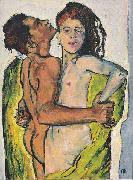China al por mayor de Marco de Oleo |
|||||||||||

|
|||||||||||
|
|
|
||||||||||||||
|
Koloman Moser
Koloman Moser (German pronunciation: [ˈkoːloman ˈmoːzɐ]) (March 30, 1868 - October 18, 1918) was an Austrian artist who exerted considerable influence on twentieth-century graphic art and one of the foremost artists of the Vienna Secession movement and a co-founder of Wiener Werkstätte. During his life, Moser designed a wide array of art works - books and graphic works from postage stamps to magazine vignettes; fashion; stained glass windows, porcelains and ceramics, blown glass, tableware, silver, jewelry, and furniture - to name a few of his interests. Born in Vienna, he studied at the Wiener Akademie and the Kunstgewerbeschule, where he also taught from 1899. His designs in architecture, furniture, jewelry, graphics, and tapestries helped characterize the work of this era. Moser drew upon the clean lines and repetitive motifs of classical Greek and Roman art and architecture in reaction to the Baroque decadence of his turn-of-the-century Viennese surroundings. In 1901/1902, he published a portfolio titled Die Quelle ("The Source") of elegant graphic designs for such things as tapestries, fabrics, and wallpaper. In 1903, Moser and his colleague Josef Hoffmann founded Wiener Werkstätte, whose studios and artisans produced a number of aesthetically and functionally designed household goods, including glassware, flatware, silverware, and textiles. In 1904, he created the Apse mosaic and glass windows for the Kirche am Steinhof in Vienna. Steinhof Church commemorative coin In 1905, together with the Klimt group, he separated from the Vienna Secession. The same year, he married Editha (Ditha) Mautner von Markhof, the daughter to one of Austria's great industry fortunes. In 1907 Kolo Moser, due to internal conflicts and as his plans for reorganising the Werkstätte (to cope with financial problems) weren't realised, withdrew from the Wiener Werkstätte. Koloman was one of the designers for Austria's leading art journal Ver Sacrum. This art journal paid great attention to design and was designed mainly by Moser, Gustav Klimt and Josef Hoffmann. |
||||||||||||||
|
|
||||||||||||||
|
||||||||||||||
|
|
||||||||||||||
| Koloman Moser
Koloman Moser (German pronunciation: [ˈkoːloman ˈmoːzɐ]) (March 30, 1868 - October 18, 1918) was an Austrian artist who exerted considerable influence on twentieth-century graphic art and one of the foremost artists of the Vienna Secession movement and a co-founder of Wiener Werkstätte. During his life, Moser designed a wide array of art works - books and graphic works from postage stamps to magazine vignettes; fashion; stained glass windows, porcelains and ceramics, blown glass, tableware, silver, jewelry, and furniture - to name a few of his interests. Born in Vienna, he studied at the Wiener Akademie and the Kunstgewerbeschule, where he also taught from 1899. His designs in architecture, furniture, jewelry, graphics, and tapestries helped characterize the work of this era. Moser drew upon the clean lines and repetitive motifs of classical Greek and Roman art and architecture in reaction to the Baroque decadence of his turn-of-the-century Viennese surroundings. In 1901/1902, he published a portfolio titled Die Quelle ("The Source") of elegant graphic designs for such things as tapestries, fabrics, and wallpaper. In 1903, Moser and his colleague Josef Hoffmann founded Wiener Werkstätte, whose studios and artisans produced a number of aesthetically and functionally designed household goods, including glassware, flatware, silverware, and textiles. In 1904, he created the Apse mosaic and glass windows for the Kirche am Steinhof in Vienna. Steinhof Church commemorative coin In 1905, together with the Klimt group, he separated from the Vienna Secession. The same year, he married Editha (Ditha) Mautner von Markhof, the daughter to one of Austria's great industry fortunes. In 1907 Kolo Moser, due to internal conflicts and as his plans for reorganising the Werkstätte (to cope with financial problems) weren't realised, withdrew from the Wiener Werkstätte. Koloman was one of the designers for Austria's leading art journal Ver Sacrum. This art journal paid great attention to design and was designed mainly by Moser, Gustav Klimt and Josef Hoffmann. Date c. 1913 Medium oil on canvas Dimensions 99,8 x 74,7 cm TTD |
||||||||||||||
|
Related Paintings to Koloman Moser :. |
||||||||||||||
|
|
||||||||||||||
|
|
||||||||||||||
|
CONTACTE EEUU |







